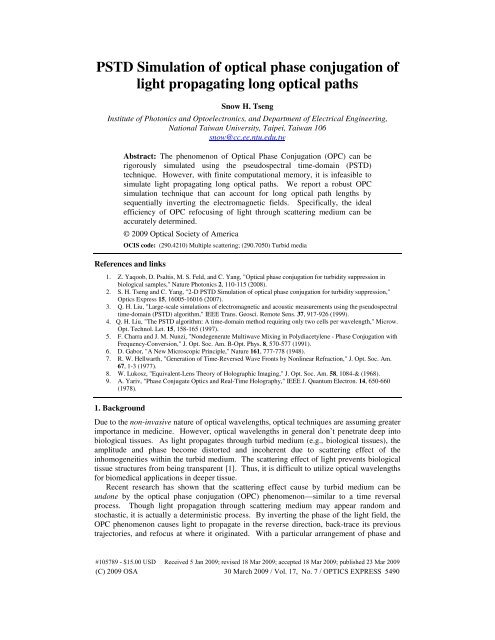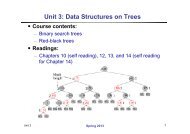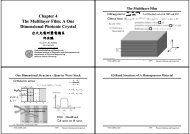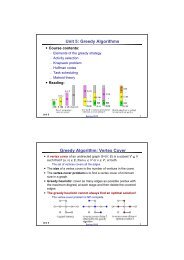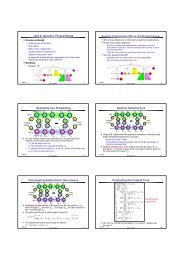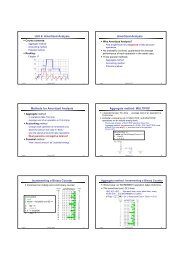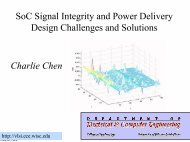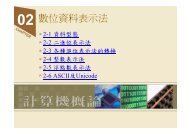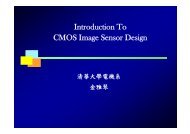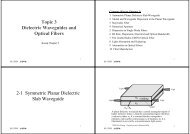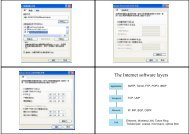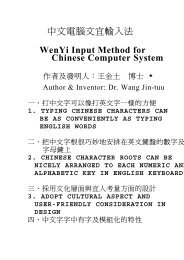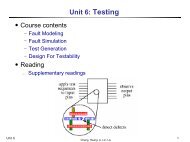S. H. Tseng, "PSTD Simulation of Optical Phase Conjugation of Light ...
S. H. Tseng, "PSTD Simulation of Optical Phase Conjugation of Light ...
S. H. Tseng, "PSTD Simulation of Optical Phase Conjugation of Light ...
You also want an ePaper? Increase the reach of your titles
YUMPU automatically turns print PDFs into web optimized ePapers that Google loves.
<strong>PSTD</strong> <strong>Simulation</strong> <strong>of</strong> optical phase conjugation <strong>of</strong><br />
light propagating long optical paths<br />
Snow H. <strong>Tseng</strong><br />
Institute <strong>of</strong> Photonics and Optoelectronics, and Department <strong>of</strong> Electrical Engineering,<br />
National Taiwan University, Taipei, Taiwan 106<br />
snow@cc.ee.ntu.edu.tw<br />
Abstract: The phenomenon <strong>of</strong> <strong>Optical</strong> <strong>Phase</strong> <strong>Conjugation</strong> (OPC) can be<br />
rigorously simulated using the pseudospectral time-domain (<strong>PSTD</strong>)<br />
technique. However, with finite computational memory, it is infeasible to<br />
simulate light propagating long optical paths. We report a robust OPC<br />
simulation technique that can account for long optical path lengths by<br />
sequentially inverting the electromagnetic fields. Specifically, the ideal<br />
efficiency <strong>of</strong> OPC refocusing <strong>of</strong> light through scattering medium can be<br />
accurately determined.<br />
© 2009 <strong>Optical</strong> Society <strong>of</strong> America<br />
OCIS code: (290.4210) Multiple scattering; (290.7050) Turbid media<br />
References and links<br />
1. Z. Yaqoob, D. Psaltis, M. S. Feld, and C. Yang, "<strong>Optical</strong> phase conjugation for turbidity suppression in<br />
biological samples," Nature Photonics 2, 110-115 (2008).<br />
2. S. H. <strong>Tseng</strong> and C. Yang, "2-D <strong>PSTD</strong> <strong>Simulation</strong> <strong>of</strong> optical phase conjugation for turbidity suppression,"<br />
Optics Express 15, 16005-16016 (2007).<br />
3. Q. H. Liu, "Large-scale simulations <strong>of</strong> electromagnetic and acoustic measurements using the pseudospectral<br />
time-domain (<strong>PSTD</strong>) algorithm," IEEE Trans. Geosci. Remote Sens. 37, 917-926 (1999).<br />
4. Q. H. Liu, "The <strong>PSTD</strong> algorithm: A time-domain method requiring only two cells per wavelength," Microw.<br />
Opt. Technol. Let. 15, 158-165 (1997).<br />
5. F. Charra and J. M. Nunzi, "Nondegenerate Multiwave Mixing in Polydiacetylene - <strong>Phase</strong> <strong>Conjugation</strong> with<br />
Frequency-Conversion," J. Opt. Soc. Am. B-Opt. Phys. 8, 570-577 (1991).<br />
6. D. Gabor, "A New Microscopic Principle," Nature 161, 777-778 (1948).<br />
7. R. W. Hellwarth, "Generation <strong>of</strong> Time-Reversed Wave Fronts by Nonlinear Refraction," J. Opt. Soc. Am.<br />
67, 1-3 (1977).<br />
8. W. Lukosz, "Equivalent-Lens Theory <strong>of</strong> Holographic Imaging," J. Opt. Soc. Am. 58, 1084-& (1968).<br />
9. A. Yariv, "<strong>Phase</strong> Conjugate Optics and Real-Time Holography," IEEE J. Quantum Electron. 14, 650-660<br />
(1978).<br />
1. Background<br />
Due to the non-invasive nature <strong>of</strong> optical wavelengths, optical techniques are assuming greater<br />
importance in medicine. However, optical wavelengths in general don’t penetrate deep into<br />
biological tissues. As light propagates through turbid medium (e.g., biological tissues), the<br />
amplitude and phase become distorted and incoherent due to scattering effect <strong>of</strong> the<br />
inhomogeneities within the turbid medium. The scattering effect <strong>of</strong> light prevents biological<br />
tissue structures from being transparent [1]. Thus, it is difficult to utilize optical wavelengths<br />
for biomedical applications in deeper tissue.<br />
Recent research has shown that the scattering effect cause by turbid medium can be<br />
undone by the optical phase conjugation (OPC) phenomenon—similar to a time reversal<br />
process. Though light propagation through scattering medium may appear random and<br />
stochastic, it is actually a deterministic process. By inverting the phase <strong>of</strong> the light field, the<br />
OPC phenomenon causes light to propagate in the reverse direction, back-trace its previous<br />
trajectories, and refocus at where it originated. With a particular arrangement <strong>of</strong> phase and<br />
#105789 - $15.00 USD Received 5 Jan 2009; revised 18 Mar 2009; accepted 18 Mar 2009; published 23 Mar 2009<br />
(C) 2009 OSA 30 March 2009 / Vol. 17, No. 7 / OPTICS EXPRESS 5490
amplitude, it is possible to cause light to interfere constructively at a targeted position within a<br />
scattering medium. In other words, the undesired scattering effect caused by scattering<br />
medium can be undone by means <strong>of</strong> OPC, and light can potentially be guided deep into<br />
biological structures. Experimental progress to utilize OPC for biomedical application has<br />
been reported [1]. However, the characteristics <strong>of</strong> OPC phenomenon is not yet well<br />
understood, further analysis is required. To analyze the optical characteristics <strong>of</strong> OPC, a<br />
simulation that can yield accurate electromagnetic field information is desired.<br />
Incident<br />
light<br />
OPC Inversion<br />
Fig. 1. Schematic <strong>of</strong> the serial OPC simulation. Incident light multiply scatters through a<br />
scattering medium consisting <strong>of</strong> N dielectric cylinders. To account for light traveling long<br />
optical paths before undergoing OPC, the electric field and magnetic field in the OPC inversion<br />
region is sequentially recorded. The recorded field information is later inserted sequentially to<br />
simulate OPC phenomenon while accounting for light propagating long optical paths.<br />
In this paper, we report an innovative OPC simulation technique that can handle light<br />
propagating long optical paths that was not feasible before. <strong>Light</strong> propagating long optical<br />
paths needs to be taken into account in order to accurately simulate the OPC phenomenon.<br />
However, with the previously reported simulation method [2], a very large simulation grid is<br />
required to account for long optical paths. Hence, the previously reported method is only<br />
applicable to optically thin scattering media; for optically thick scattering media, an<br />
enormously large computational grid is required to account for long propagating light and is<br />
therefore infeasible. In this paper, we propose an advanced OPC simulation technique that<br />
can account for light propagating long optical paths. The proposed OPC simulation technique<br />
enables determining the ideal OPC refocusing efficiency <strong>of</strong> light through macroscopic<br />
optically-thick, scattering medium that was not possible to simulate with previously reported<br />
methods.<br />
2. Serial OPC simulation<br />
A schematic <strong>of</strong> the serial OPC simulation is shown in Fig. 1. The pseudospectral time-domain<br />
(<strong>PSTD</strong>) technique [3, 4] is implemented to simulate the OPC phenomenon <strong>of</strong> a 2-D phase<br />
#105789 - $15.00 USD Received 5 Jan 2009; revised 18 Mar 2009; accepted 18 Mar 2009; published 23 Mar 2009<br />
(C) 2009 OSA 30 March 2009 / Vol. 17, No. 7 / OPTICS EXPRESS 5491
conjugate mirror (PCM). Based on Maxwell’s equations, the <strong>PSTD</strong> method is a grid-based<br />
technique capable <strong>of</strong> simulating light scattering by arbitrary geometries. The simulation<br />
reported in this paper is performed with a spatial resolution <strong>of</strong> 0.33 µm and temporal<br />
resolution <strong>of</strong> 0.05 fs. A scattering medium consisting <strong>of</strong> randomly-positioned dielectric<br />
cylinders is placed adjacent to a PCM in vacuum. Considering the scattering effect caused by<br />
refractive index mismatch between different biological structures and surround medium, a<br />
typical refractive index <strong>of</strong> n = 1.2 is assigned to each dielectric cylinder. The scattering<br />
medium is illuminated by a light pulse; the light pulse scatters through the scattering medium<br />
via complex optical paths and impinges the PCM.<br />
The OPC phenomenon <strong>of</strong> a PCM is simulated by sequentially inverting the<br />
electromagnetic field within the OPC inversion region at constant time intervals. When light<br />
impinges a PCM, the poynting vector is inverted and light then propagates in reversed<br />
directions. To simulate OPC, the H-field and B-field are manually inverted:<br />
H → − H, B → − B ,<br />
(1)<br />
with the E-field and D-field kept unchanged. Thus, the phase conjugated light then<br />
propagates in reversed directions. To account for light propagating long (and short) optical<br />
paths before reaching the OPC inversion region, the optical field in the OPC inversion region<br />
is sequentially inserted into the simulation grid. Details <strong>of</strong> the simulation are described as<br />
follows.<br />
3. Storing the electromagnetic fields for sequential OPC inversion<br />
As shown in Fig. 2, the E- and H- fields <strong>of</strong> the scattered light within the OPC inversion region<br />
are stored every T timesteps. For the simulations reported in this paper,<br />
T = 4000 timesteps is chosen, corresponding to a temporal duration <strong>of</strong> 0.2 ps. T cannot be too<br />
large where light transpasses the OPC inversion region without being recorded. An<br />
appropriate T is chosen so that all light entering the OPC inversion region is stored before<br />
exiting the OPC inversion region. In addition, there should be overlap <strong>of</strong> the stored field <strong>of</strong><br />
the OPC inversion region; the overlapped fields are essential for connecting the stored OPC<br />
inversion fields. The stored OPC electromagnetic fields are later sequentially inserted to<br />
reconstruct the OPC phenomenon <strong>of</strong> light.<br />
4. Sequential OPC inversion <strong>of</strong> scattered light<br />
As depicted in Fig. 3, the previously stored E-field and H-field [Fig. 3(a)-(d)] are OPC<br />
inverted and sequentially inserted into the simulation grid. The OPC phenomenon inverts the<br />
poynting vector and causes light to propagate in reversed directions. Each insertion <strong>of</strong> the<br />
OPC inverted fields is equally spaced in time by T timesteps, the same as storing the E-field<br />
and H-field (as shown in Fig. 2).<br />
By sequentially stitching together the OPC inverted field, the OPC inverted<br />
electromagnetic field <strong>of</strong> light propagating various long optical paths can be reconstructed. As<br />
shown in Fig. 4. (Media 1), the OPC inverted field at various timesteps are sequentially<br />
stitched together to reconstruct the OPC reversed propagation <strong>of</strong> light. In Fig. 4(a): the light<br />
pulse propagates in the reverse direction (towards left). Notice that the pr<strong>of</strong>ile <strong>of</strong> the<br />
wavefront is imperfect—the middle section breaks apart with an opening. This defect is a<br />
result <strong>of</strong> OPC inversion <strong>of</strong> incomplete optical wavefront. As shown in Figs. 4(b) and 4(c), T<br />
timesteps later, the next OPC inverted field is inserted to cover up and replace the erroneous<br />
artifacts caused by OPC <strong>of</strong> incomplete field. After sequentially “stitching” all OPC inverted<br />
fields together, all the artifacts are sequentially replaced by correct field values to reconstruct<br />
the OPC refocusing <strong>of</strong> light propagating long optical paths.<br />
#105789 - $15.00 USD Received 5 Jan 2009; revised 18 Mar 2009; accepted 18 Mar 2009; published 23 Mar 2009<br />
(C) 2009 OSA 30 March 2009 / Vol. 17, No. 7 / OPTICS EXPRESS 5492
Incident<br />
light<br />
OPC<br />
reversed<br />
light<br />
OPC inversion<br />
(a) (b) (c) (d)<br />
Fig. 2. The electric fields and magnetic fields <strong>of</strong> the OPC inversion region are recorded every T<br />
timesteps (corresponding to 0.2 ps). Electromagnetic fields at equal time intervals (T = 4000<br />
timesteps) are stored in series: (a): 1×T, (b): 2×T, (c): 3×T, and (d): 4×T. The interval T is<br />
chosen so that the OPC inversion fields overlap each other. The recorded field information is<br />
later inserted sequentially to simulate OPC reversed light propagation.<br />
(a) (b) (c) (d)<br />
Fig. 3. The recorded electric fields and magnetic fields are sequentially inserted into the OPC<br />
inversion region every T timesteps to simulate light propagating long optical paths.<br />
#105789 - $15.00 USD Received 5 Jan 2009; revised 18 Mar 2009; accepted 18 Mar 2009; published 23 Mar 2009<br />
(C) 2009 OSA 30 March 2009 / Vol. 17, No. 7 / OPTICS EXPRESS 5493
(a) (b) (c) (d)<br />
OPC Inversion Region<br />
Fig. 4. (Media 1) Sequentially stitching the OPC inverted field to reconstruct the OPC reversed<br />
propagation <strong>of</strong> light. The E- fields <strong>of</strong> the OPC inverted field at various time steps are shown:<br />
T = (a) 59001, (b) 60000, (c) 60001, and (d) 61000 timesteps. (a): after OPC, light propagates<br />
in the reverse direction (towards left); defect <strong>of</strong> the reconstructed wavefront is a result <strong>of</strong> OPC<br />
inversion <strong>of</strong> incomplete electromagnetic field. Later, as shown in (b) and (c), the next OPC<br />
inverted field is inserted to replace the artifacts, resulting in (d): a perfect OPC reversed<br />
propagation <strong>of</strong> light.<br />
5. Effectiveness <strong>of</strong> the OPC refocusing <strong>of</strong> light through scattering medium<br />
We employ the proposed serial simulation technique to analyze the effectiveness <strong>of</strong> the OPC<br />
refocusing <strong>of</strong> light through scattering medium. The effectiveness <strong>of</strong> OPC refocusing<br />
phenomenon depends mainly on two factors: i) OPC efficiency <strong>of</strong> the PCM, and, ii)<br />
percentage <strong>of</strong> incident light reaching the PCM. Depending on the specific mechanism <strong>of</strong> the<br />
PCM, the OPC efficiency varies [5-9]. For practical applications to focus light within turbid<br />
medium, it is important to accurately determine the percentage <strong>of</strong> light reaching the PCM. By<br />
employing the proposed simulation technique, we can simulate the OPC phenomenon for a<br />
PCM with ideal efficiency and determine the effectiveness <strong>of</strong> OPC refocusing <strong>of</strong> light<br />
multiply scattering through a scattering medium.<br />
Next, we analyze the contribution <strong>of</strong> light propagating through the scattering medium via<br />
various optical path lengths. The OPC refocusing <strong>of</strong> light consists <strong>of</strong> light propagating short<br />
and long optical paths. The contribution <strong>of</strong> light propagating different optical path lengths can<br />
be determined by running the serial OPC simulation for various temporal durations. The<br />
physical thickness <strong>of</strong> the scattering medium is 240 µm. We employ the serial OPC simulation<br />
for various durations: from 0.8 to 32 ps (in 32 ps, light propagates a distance <strong>of</strong> 9600 µm in<br />
vacuum). As shown in Fig. 5, the energy <strong>of</strong> the OPC refocused light energy converges. For a<br />
typical scattering medium with optical thickness <strong>of</strong> 4.65 (for wavelength λ = 1 µm), a<br />
simulation <strong>of</strong> temporal duration 8 ps is required to account for all light propagating long and<br />
short optical paths. Furthermore, the simulation results show that the ideal OPC refocusing<br />
efficiency <strong>of</strong> light through a typical scattering medium is ~15%; energy loss occurs in the<br />
forward propagation before impinging the PCM. Though only a fraction <strong>of</strong> light undergoes<br />
#105789 - $15.00 USD Received 5 Jan 2009; revised 18 Mar 2009; accepted 18 Mar 2009; published 23 Mar 2009<br />
(C) 2009 OSA 30 March 2009 / Vol. 17, No. 7 / OPTICS EXPRESS 5494
OPC, the OPC effect causes light to propagate in reversed directions through the scattering<br />
medium and refocus without loss.<br />
6. Discussions<br />
OPC refocused energy (%)<br />
20<br />
15<br />
10<br />
5<br />
0<br />
0 10 20<br />
duration (ps)<br />
30<br />
Fig. 5. The total OPC refocused energy vs. duration <strong>of</strong> the serial OPC simulation. <strong>Light</strong><br />
traveling long optical paths before reaching the OPC inversion region is accommodated by<br />
long duration <strong>of</strong> the serial OPC simulation. Ideally, the total OPC refocused energy is the total<br />
energy <strong>of</strong> light that impinges the PCM.<br />
To accurately model the OPC phenomenon <strong>of</strong> light propagating long optical paths through a<br />
large-scale scattering medium, the previously reported simulation technique [2] falls short as<br />
it requires an enormous amount <strong>of</strong> computations. For example, with an 8-core Xeon<br />
Woodcrest 3.0GHz processor, a typical OPC simulation as shown in this paper accounting for<br />
optical paths <strong>of</strong> as long as 9,600 µm would require a runtime <strong>of</strong> ~1,600 hours. With the<br />
proposed serial simulation technique reported in this paper, the runtime is reduced to ~167<br />
hours. Therefore, the proposed serial simulation technique dramatically reduces the computer<br />
requirements for simulating the OPC phenomenon <strong>of</strong> light propagating long optical paths.<br />
As shown in this paper, the reported serial OPC simulation technique is achieved by<br />
storing and later sequentially stitching the OPC inversion fields together. Based on the<br />
mathematical characteristics <strong>of</strong> Maxwell’s equations, electromagnetic field values are affected<br />
only by local field derivatives and depend little on remote field values; thus, the OPC stitching<br />
<strong>of</strong> electromagnetic field enables reconstructing the macroscopic scattered light field with<br />
some artifacts due to discontinuities <strong>of</strong> the sequential OPC field inversion. The simulation<br />
artifacts only affect local field values and are later corrected by sequentially inserted OPC<br />
inversion field values. After sequentially inserting all OPC inverted fields, the OPC inverted<br />
propagation <strong>of</strong> light is reconstructed without error.<br />
In summary, by sequentially stitching together the electromagnetic fields, the OPC<br />
phenomenon <strong>of</strong> light multiply scattering through optically thick scattering medium can be<br />
simulated with limited computational memory. The proposed simulation technique enables<br />
OPC simulation <strong>of</strong> light propagating long, sinuous optical paths that is not possible otherwise.<br />
Furthermore, the ideal efficiency <strong>of</strong> OPC refocusing <strong>of</strong> light through scattering medium can<br />
be accurately determined.<br />
Acknowledgments<br />
The author thanks Changhuei Yang and Emily McDowell for insightful discussions. The<br />
author thanks the Taiwan National Science Council Grant NSC-96-2112-M-002-028-MY3 for<br />
the support <strong>of</strong> this research.<br />
#105789 - $15.00 USD Received 5 Jan 2009; revised 18 Mar 2009; accepted 18 Mar 2009; published 23 Mar 2009<br />
(C) 2009 OSA 30 March 2009 / Vol. 17, No. 7 / OPTICS EXPRESS 5495


